Elements’ Content in Stream Sediment and Wildfire Ash of Suburban Areas in West Attica (Greece)
Abstract
:1. Introduction
2. Materials and Methods
2.1. Sampling
2.2. Pretreatment of Sediment and Ash Samples
2.3. Grain Size Distribution
2.4. Measurement of Physicochemical Stream Sediment Properties
2.5. Determination of Elements in Wildfire Ash
2.6. Data Treatment and Spatial Representation
3. Results and Discussion
3.1. Physicochemical Properties of Stream Sediments
3.1.1. DTPA-Extractable Elements Content in Stream Sediments
3.1.2. Elements Content in Ash
3.1.3. Evaluating Elements’ Contamination Sources in Stream Sediments
4. Conclusions
Author Contributions
Funding
Data Availability Statement
Acknowledgments
Conflicts of Interest
References
- Robotham, J.; Old, G.; Rameshwaran, P.; Sear, D.; Gasca-Tucker, D.; Bishop, J.; Old, J.; McKnight, D. Sediment and Nutrient Retention in Ponds on an Agricultural Stream: Evaluating Effectiveness for Diffuse Pollution Mitigation. Water 2021, 13, 1640. [Google Scholar] [CrossRef]
- Alvarenga, P.; Guerreiro, N.; Simões, I.; Imaginário, M.J.; Palma, P. Assessment of the Environmental Impact of Acid Mine Drainage on Surface Water, Stream Sediments, and Macrophytes Using a Battery of Chemical and Ecotoxicological Indicators. Water 2021, 13, 1436. [Google Scholar] [CrossRef]
- Hao, J.; Ren, J.; Fang, H.; Tao, L. Identification Sources and High-Risk Areas of Sediment Heavy Metals in the Yellow River by Geographical Detector Method. Water 2021, 13, 1103. [Google Scholar] [CrossRef]
- Leko Kos, M.; Tadić, L. The Field-Scale Investigation of the Low Mobility of Drainage Canal Sediments Polluted by Copper in Lowland Area of Croatia. Water 2021, 13, 677. [Google Scholar] [CrossRef]
- Sakan, M.S.; Dordevic, S.D.; Trifunovic, S.S. Geochemical and statistical methods in the evaluation of trace elements contamination: An application on canal sediments. Pol. J. Environ. Stud. 2011, 20, 187–189. [Google Scholar]
- Mantei, E.J.; Foster, M.V. Heavy metals in stream sediments: Effect of human activities. Environ. Geol. Water Sci. 1991, 18, 95–104. [Google Scholar] [CrossRef]
- Benamar, M.A.; Toumert, S.; Tobbeche, A.T.; Chalabi, A. Assessment of the state of pollution by heavy metals in the surfacial sediments of Algeris Bay. Appl. Radiat. Isot. 1999, 50, 975–980. [Google Scholar] [CrossRef]
- Papadopoulou-Vrynioti, Κ.; Alexakis, D.; Bathrellos, G.D.; Skilodimou, H.D.; Vryniotis, D.; Vassiliades, E.; Gamvroula, D. Distribution of trace elements in stream sediments of Arta plain (western Hellas): The influence of geomorphological parameters. J. Geoch Explor. 2013, 134, 17–26. [Google Scholar] [CrossRef]
- Alexakis, D.; Gamvroula, D. Arsenic, chromium, and other potentially toxic elements in the rocks and sediments of Oropos-Kalamos basin, Attica, Greece. Appl. Environ. Soil Sci. 2014, 2014, 718534. [Google Scholar] [CrossRef] [Green Version]
- Shaheen, S.M.; Rinklebe, J. Geochemical fractions of chromium, copper, and zinc and their vertical distribution in floodplain soil profiles along the Central Elbe River, Germany. Geoderma 2014, 228–229, 142–159. [Google Scholar] [CrossRef]
- Gassama, N.; Curie, F.; Vanhooydonck, P.; Bourrain, X.; Widory, D. Determining the Regional Geochemical Background for Dissolved Trace Metals and Metalloids in Stream Waters: Protocol, Results and Limitations—The Upper Loire River Basin (France). Water 2021, 13, 1845. [Google Scholar] [CrossRef]
- Alexakis, D. Suburban areas in flames: Dispersion of potentially toxic elements from burned vegetation and buildings. Estimation of the associated ecological and human health risk. Environ. Res. 2020, 183, 109153. [Google Scholar] [CrossRef]
- Bing, H.; Zhou, J.; Wu, Y.; Wang, X.; Sun, H.; Li, R. Current state, sources and Potential risk of heavy metals in sediments of three gorges reservoir, China. Environ. Pollut. 2016, 214, 485–496. [Google Scholar] [CrossRef]
- Das, P.; Kumar, M.; Sarma, K.P. Speciation of heavy metals in surface sentiment of the Brahmaputra river, Assam, India. J. Environ. Res. Dev. 2015, 9, 944–952. [Google Scholar]
- Omwene, P.I.; Öncel, M.S.; Çelen, M.; Kobya, M. Heavy metal pollution and spatial distribution in surface sediments of Mustafakemalpaşa stream located in the world’s largest borate basin (Turkey). Chemosphere 2018, 208, 782–792. [Google Scholar] [CrossRef]
- Sekabira, K.; Origa, H.O.; Basamba, T.A.; Mutumba, G.; Kakudidi, E. Assessment of heavy metal pollution in the urban stream sediments and its tributaries. Int. J. Environ. Sci. Technol. 2010, 7, 435–446. [Google Scholar] [CrossRef] [Green Version]
- Swindle, C.; Shankin-Clarke, P.; Meyerhof, M.; Carlson, J.; Melack, J. Effects of Wildfires and Ash Leaching on Stream Chemistry in the Santa Ynez Mountains of Southern California. Water 2021, 13, 2402. [Google Scholar] [CrossRef]
- Walling, D.E. Tracing suspended sediment sources in catchments and river systems. Sci. Total Environ. 2005, 344, 159–184. [Google Scholar] [CrossRef] [PubMed]
- Glaser, C.; Zarfl, C.; Rügner, H.; Lewis, A.; Schwientek, M. Analyzing Particle-Associated Pollutant Transport to Identify In-Stream Sediment Processes during a High Flow Event. Water 2020, 12, 1794. [Google Scholar] [CrossRef]
- Bezes, C. New Neotectonic Map of Greece. Sheet 420_4200 (1:25.000). 2011. Available online: http://geolokarta.blogspot.com/search/label/Kineta (accessed on 24 April 2021).
- Bezes, C. New Neotectonic Map of Greece. Sheet 440_4200 (1:25.000). 2011. Available online: http://geolokarta.blogspot.com/search/label/Megara (accessed on 24 April 2021).
- Gamvroula, D.; Alexakis, D.; Stamatis, G. Diagnosis of groundwater quality and assessment of contamination sources in the Megara basin (Attica, Greece). Arab. J. Geosci. 2013, 6, 2367–2381. [Google Scholar] [CrossRef]
- Kaplanis, A.; Koukouvelas, I.; Xypolias, P.; Kokkalas, S. Kinematics and ophiolite obduction in the Gerania and Helicon Mountains, central Greece. Tectonophysics 2013, 595–596, 215–234. [Google Scholar] [CrossRef]
- Alexakis, D. Human health risk assessment associated with Co, Cr, Mn, Ni and V contents in agricultural soils from a Mediterranean site. Arch. Agron. Soil Sci. 2016, 62, 359–373. [Google Scholar] [CrossRef]
- Alexakis, D.; Gamvroula, D.; Theofili, E. Environmental availability of potentially toxic elements in an agricultural Mediterranean site. Environ. Eng. Geosci. 2019, 25, 169–178. [Google Scholar] [CrossRef]
- Alexakis, D. Contaminated land by wildfire effect on ultramafic soil and associated human health and ecological risk. Land 2020, 9, 409. [Google Scholar] [CrossRef]
- Google Earth. Greece, World Imagery. Available online: https://earth.google.com/web (accessed on 17 December 2021).
- Copernicus-Emergency Management Service-Mapping (EMS). EMSR257: Flood in Attica, Greece. 2017. Available online: https://emergency.copernicus.eu/mapping/list-of-components/EMSR257 (accessed on 15 April 2019).
- Copernicus-Emergency Management Service-Mapping (EMS). EMSR300: Forest Fires in Attica, Greece. 2018. Available online: https://emergency.copernicus.eu/mapping/list-of-components/EMSR300 (accessed on 18 September 2018).
- Bouyoucos, G.J. Hydrometer method improved for making particle size analysis of soils. Agron. J. 1962, 54, 464–465. [Google Scholar] [CrossRef]
- Hendershot, W.H.; Duquette, M. A simple barium chloride method for determining cation exchange capacity and exchangeable cations. Soil Sci. Soc. Am. J. 1986, 50, 605–608. [Google Scholar] [CrossRef]
- Walkley, A.; Black, I.A. An examination of the Degtjareff method for determining soil organic matter and a proposed modification of the chromic acid titration method. Soil Sci. 1934, 37, 29–38. [Google Scholar] [CrossRef]
- Lindsay, W.L.; Norvell, W.A. Development of a DTPA soil test for zinc, iron, manganese and copper. Soil Sci. Soc. Am. J. 1978, 42, 421–428. [Google Scholar] [CrossRef]
- ISO 11466:1995. Soil Quality–Extraction of Trace Elements Soluble in Aqua Regia; International Organization for Standardization: Geneva, Switzerland, 1995. [Google Scholar]
- Tukey, J.W. Exploratory Data Analysis, 1st ed.; Addison-Wesley: Boston, MA, USA, 1977; p. 712. [Google Scholar]
- College of Tropical Agriculture and Human Resources (CTAHR). Available online: https://www.ctahr.hawaii.edu/mauisoil/a_factor_ts.aspx (accessed on 30 January 2021).
- Alexakis, D. Diagnosis of stream sediment quality and assessment of toxic element contamination sources in East Attica. Environ. Earth Sci. 2011, 63, 1369–1393. [Google Scholar] [CrossRef]
- Faria, S.R.; De La Rosa, J.M.; Knicker, H.; Gonzalez-Perez, J.A.; Keizer, J.J. Molecular characterization of wildfire impacts on organic matter in eroded sediments and topsoil in Mediterranean Eucalypt stands. Catena 2015, 135, 29–37. [Google Scholar] [CrossRef]
- Vincent, A.; Osakwe, A.S.; Osaro, K.I.; Weltime, O.M. Post flooding effect on soil quality in Nigeria: The Asaba, Onitsha experience. Open J. Soil Sci. 2014, 4, 72–80. [Google Scholar]
- De Marco, A.; Gentile, A.E.; Arena, C.; De Santo, A.V. Organic matter, nutrient content and biological activity in burned and unburned soils of a Mediterranean maquis area of southern Italy. Int. J. Wildland Fire 2005, 14, 365–377. [Google Scholar] [CrossRef]
- Hazelton, P.; Murphy, B. Interpreting Soil Test Results. What Do All the Numbers Mean? 2nd ed.; CSIRO: Canberra, Australia, 2007; p. 160. [Google Scholar]
- Ahmad, Z.A.; Nur, A.S.; Nadzhratul, H. Influential factors on the levels of cation exchange capacity in sediment at Langat River. Arab. J. Geosci. 2012, 6, 3049–3058. [Google Scholar]
- Ketterings, Q.; Reid, S.; Rao, R. Cation Exchange Capacity (CEC); Department of Crop and Soil Sciences and College of Agriculture and Life Sciences: Ithaca, NY, USA, 2007; Available online: http://nmsp.cals.cornell.edu (accessed on 17 May 2021).
- Saengkul, C.; Pakkong, P.; Sawangwong, P. Effect of sediment characteristics on sorption of 137Cs at the sediment-water interface. IOSR J. Environ. Sci. Toxicol. Food Technol. 2013, 4, 122–125. [Google Scholar]
- Ubuoh, E.A.; Uka, A.; Egbe, C. Effects of flooding on soil quality in Abaliki agroecological zone of South-Eastern State, Nigeria. J. Environ. Chem. Ecotoxicol. Res. 2016, 1, 20–32. [Google Scholar]
- Parra, J.G.; Rivero, V.C.; Lopez, T.I. Forms of Mn in soils affected by a forest fire. Sci. Total Environ. 1996, 188, 231–236. [Google Scholar] [CrossRef]
- Hakanson, L. An ecological risk index for aquatic pollution control. A sedimentological approach. Water Res. 1980, 14, 975–1001. [Google Scholar] [CrossRef]
- Wan, X.; Li, C.; Parikh, S.C. Chemical composition of soil-associated ash from the southern California Thomas Fire and its potential inhalation risks to farmworkers. J. Environ. Manag. 2021, 278, 111570. [Google Scholar] [CrossRef] [PubMed]
- Pereira, P.; Ubeda, X. Spatial distribution of heavy metals released from ashes after a wildfire. J. Environ. Eng. Landsc. Manag. 2010, 18, 13–22. [Google Scholar] [CrossRef]
- Silva, V.; Pereira, J.L.; Campos, I.; Keizer, J.J.; Goncalves, F.; Abrantes, N. Toxicity assessment of aqueous extracts of ash from forest fires. Catena 2015, 135, 401–408. [Google Scholar] [CrossRef]
- Harper, A.; Santin, C.; Doerr, S.H.; Froyd, C.; Albini, D.; Otero, X.; Vinas, L.; Perez-Fernandez, B. Chemical composition of wildfire ash produced in contrasting ecosystems and its toxicity to Daphnia magna. Int. J. Wildl. Fire 2019, 28, 726–737. [Google Scholar] [CrossRef] [Green Version]
- Salminen, R.; Batista, M.J.; Bidovec, M.; Demetriades, A.; De Vivo, B.; De Vos, W.; Duris, M.; Gilucis, A.; Gregorauskiene, V.; Halamic, J.; et al. FOREGS Geochemical Atlas of Europe Part 1. Background Information, Methodology and Maps. Geol. Surv. Finl. Espoo 2005. Available online: http://weppi.gtk.fi/publ/foregsatlas/ (accessed on 17 December 2021).
- Kennedy, N.D.; Wheeler, P.D.; Wilson, P. Compilation of Sediment and Soil Standards Criteria & Guidelines. State of California, the Resources Agency and Department of Water Resources, 1995. Available online: https://www.scribd.com/document/371350899/Compilation-of-Soil-and-Sediment-Standards-Criteria-and-Guidelines-February-1995 (accessed on 21 May 2021).
- Alexakis, D.; Kokmotos, I.; Gamvroula, D.; Varelidis, G. Wildfire effects on soil quality. Application on a suburban area of West Attica (Greece). Geosci. J. 2021, 25, 243–253. [Google Scholar] [CrossRef]
- Breeuwsma, A.; Wosten, J.H.M.; Vleeshouwer, J.J.; Van Slobbe, A.M.; Bouma, J. Derivation of land qualities to assess environmental problems from soil surveys. Soil Sci. Soc. Am. J. 1986, 50, 186–190. [Google Scholar] [CrossRef]
- Appelo, C.A.J.; Postma, D. Geochemistry, Groundwater and Pollution, 2nd ed.; Balkema, A.A., Ed.; CRC Press: Leiden, The Netherland, 2005; p. 647. [Google Scholar]
- Garcia-Marco, S.; Gonzalez-Prieto, S. Short and medium term effects of fire and firefighting chemicals on soil micronutrient availability. Sci. Total Environ. 2008, 407, 297–303. [Google Scholar] [CrossRef] [PubMed] [Green Version]
- Close, D.C.; Davidson, N.J.; Swanborough, P.W.; Corkrey, R. Does low-intensity surface fire increase water- and nutrient–availability to overstorey Eucalyptus gomphocephala? Plant Soil 2011, 349, 203–214. [Google Scholar] [CrossRef]
- Gómez-Rey, M.X.; González-Prieto, S.J. Short and medium term effects of a wildfire and two emergency stabilization treatments on the availability of macronutrients and trace elements in topsoil. Sci. Total Environ. 2014, 493, 251–261. [Google Scholar] [CrossRef] [Green Version]
- Campos, I.; Abrantes, N.; Keizer, J.J.; Vale, C.; Pereira, P. Major and trace elements in soils and ashes of eucalypt and pine forest plantations in Portugal following a wildfire. Sci. Total Environ. 2016, 572, 1363–1376. [Google Scholar] [CrossRef]
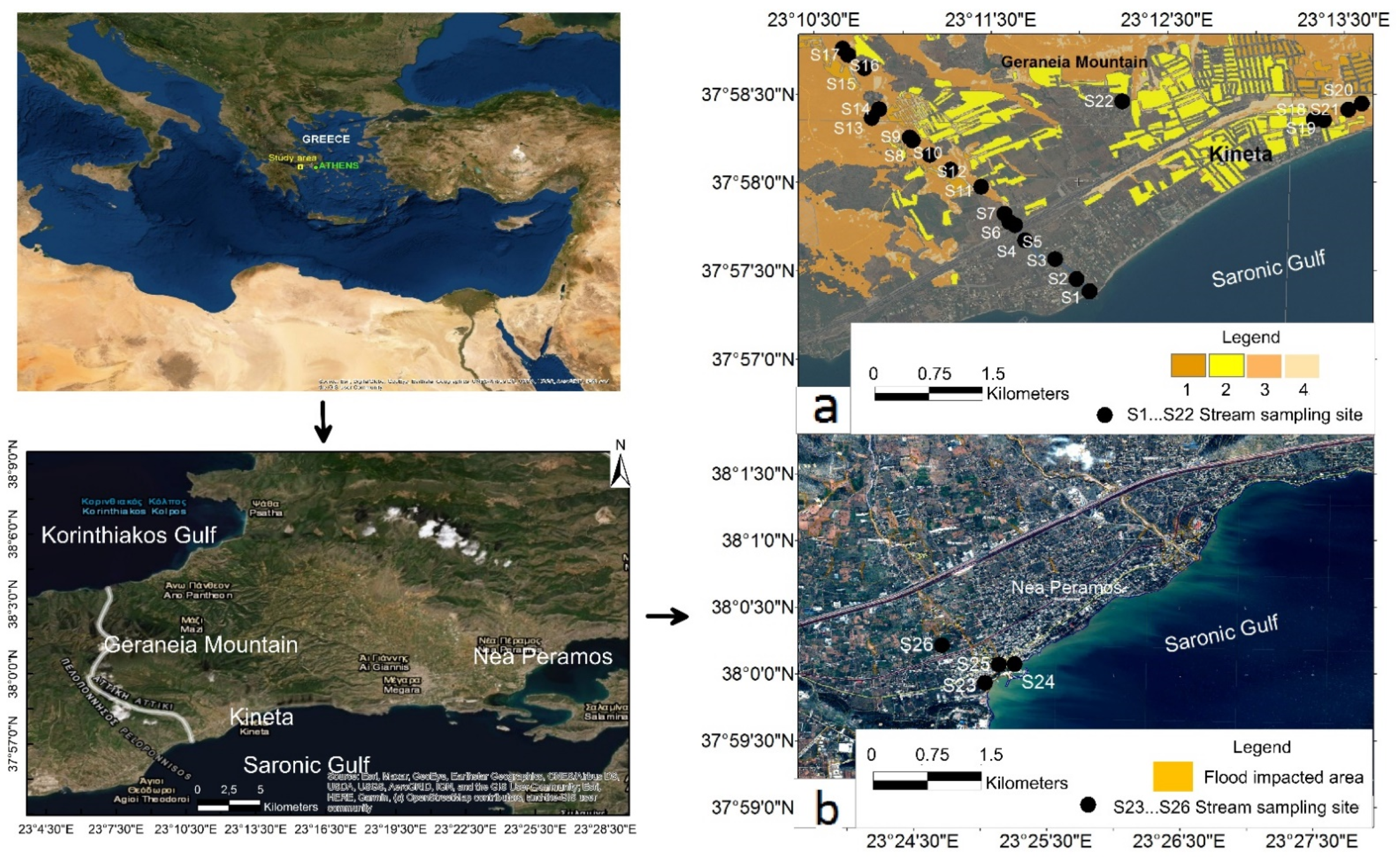

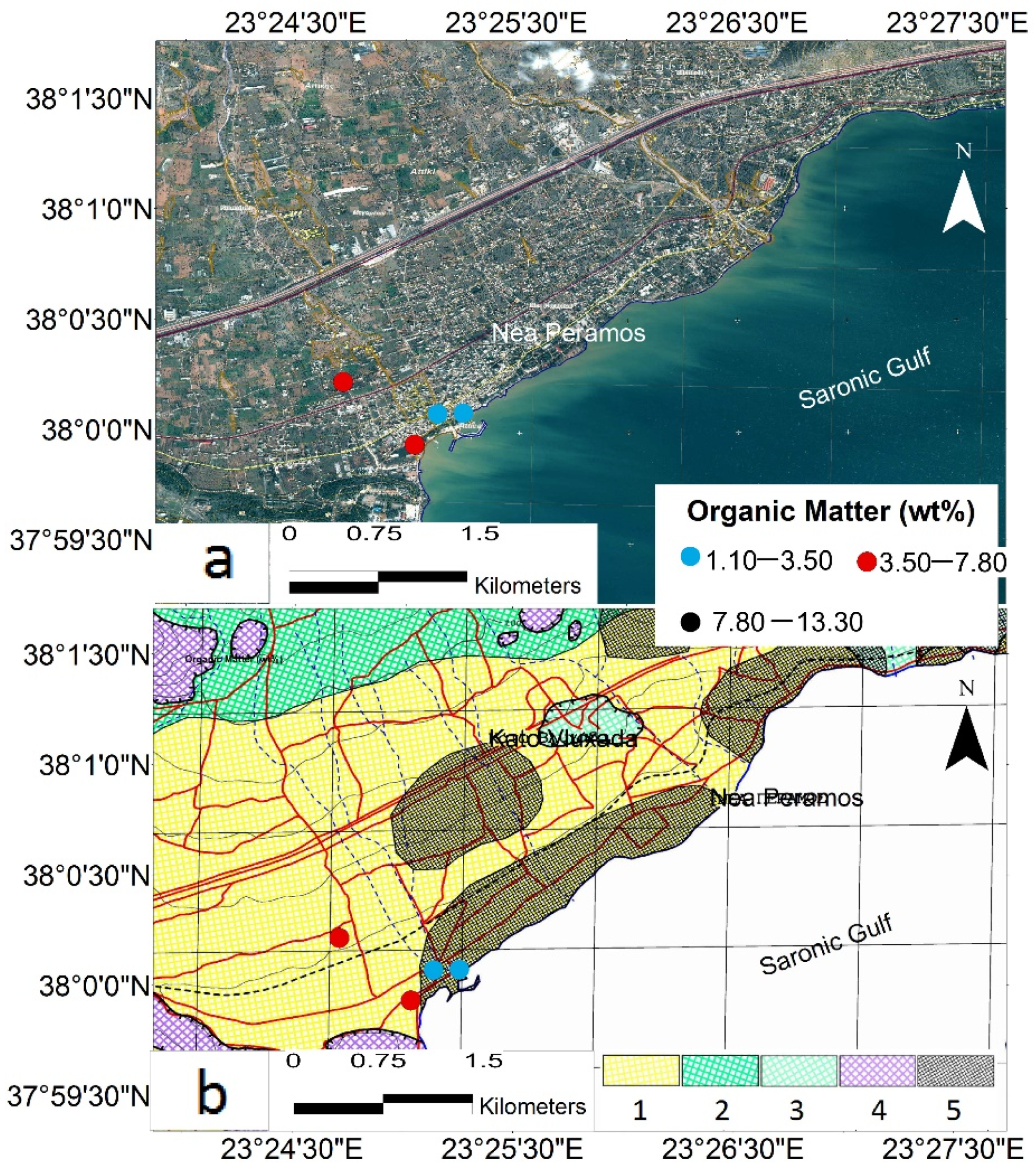
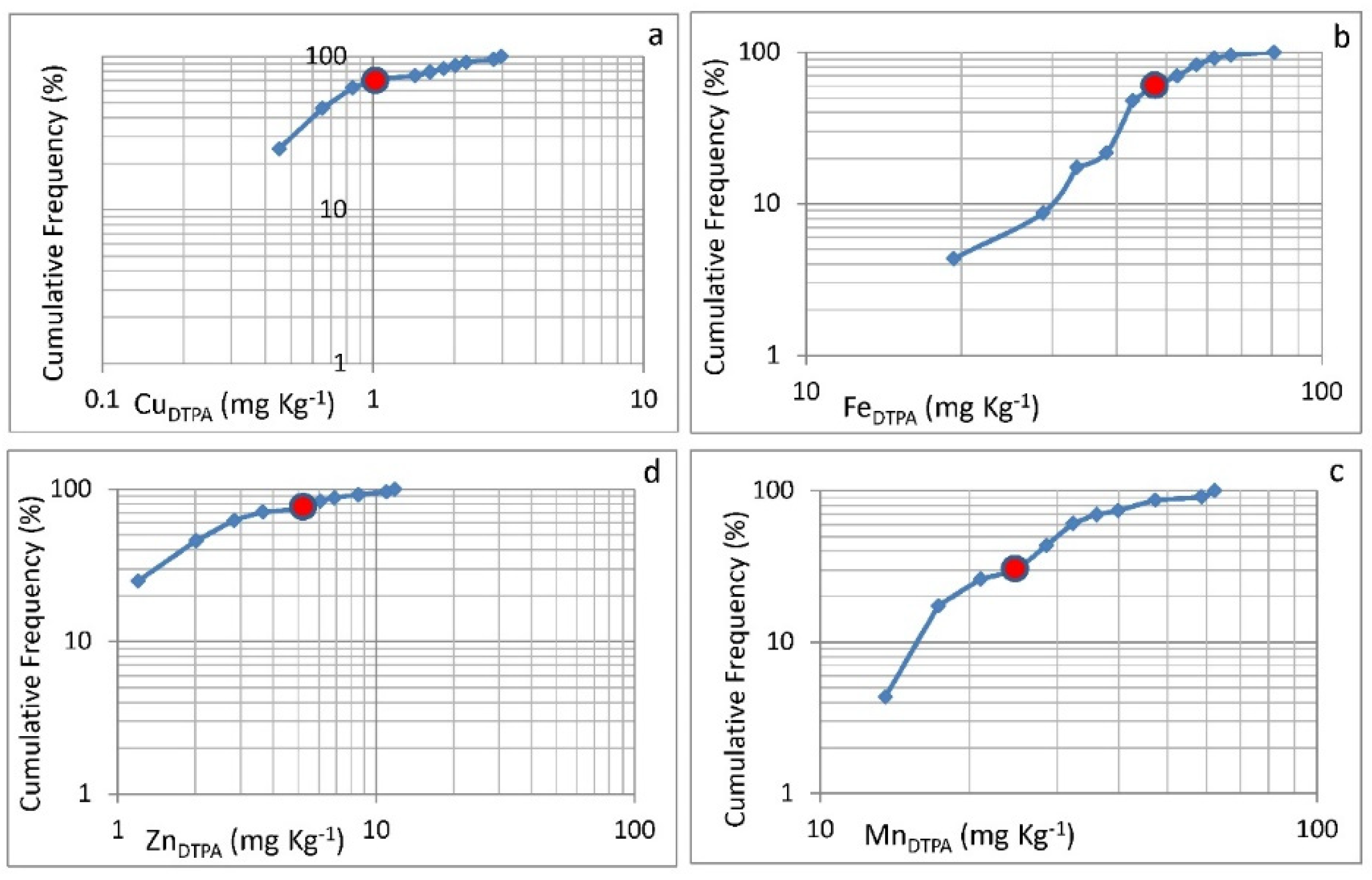
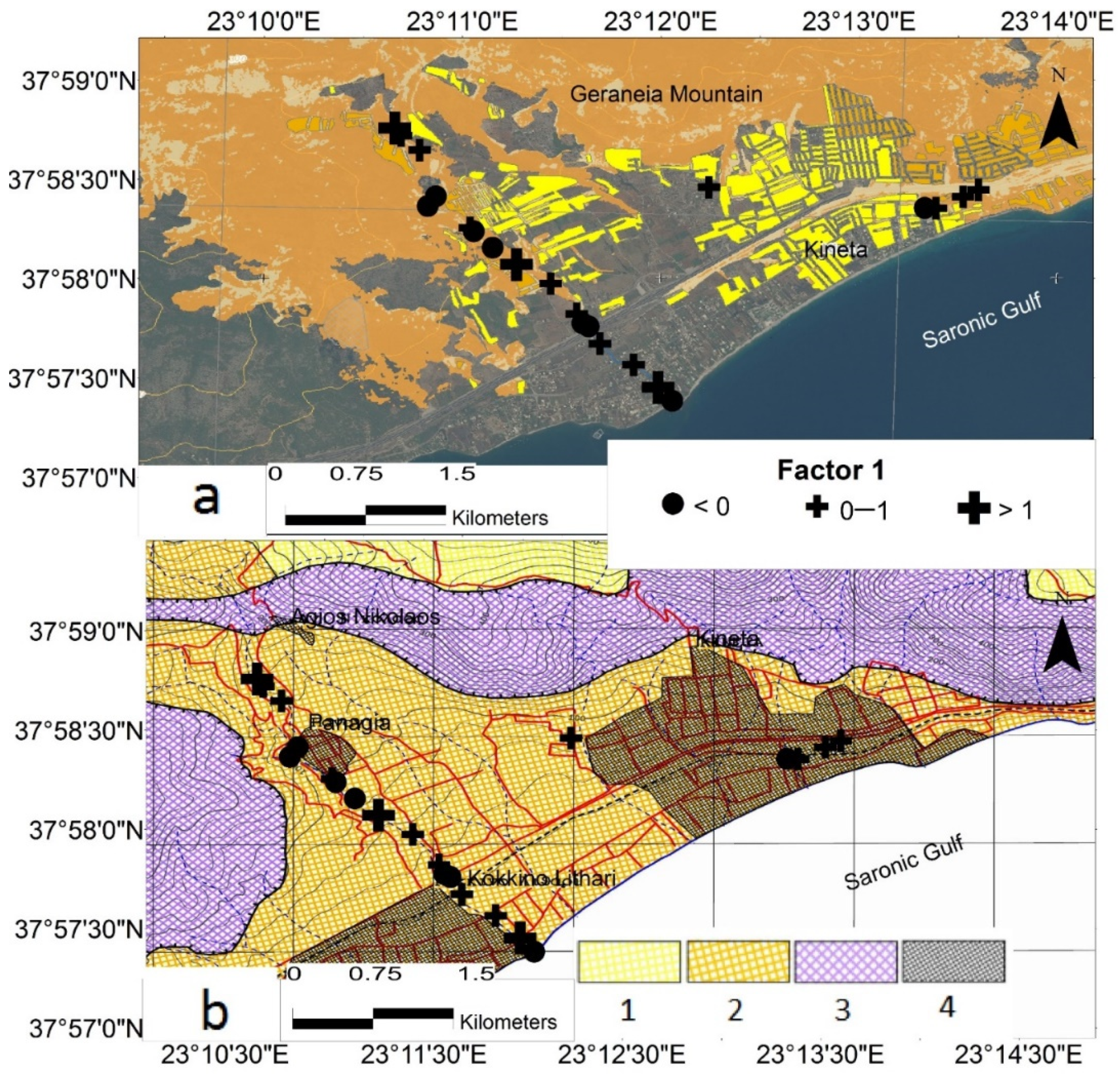

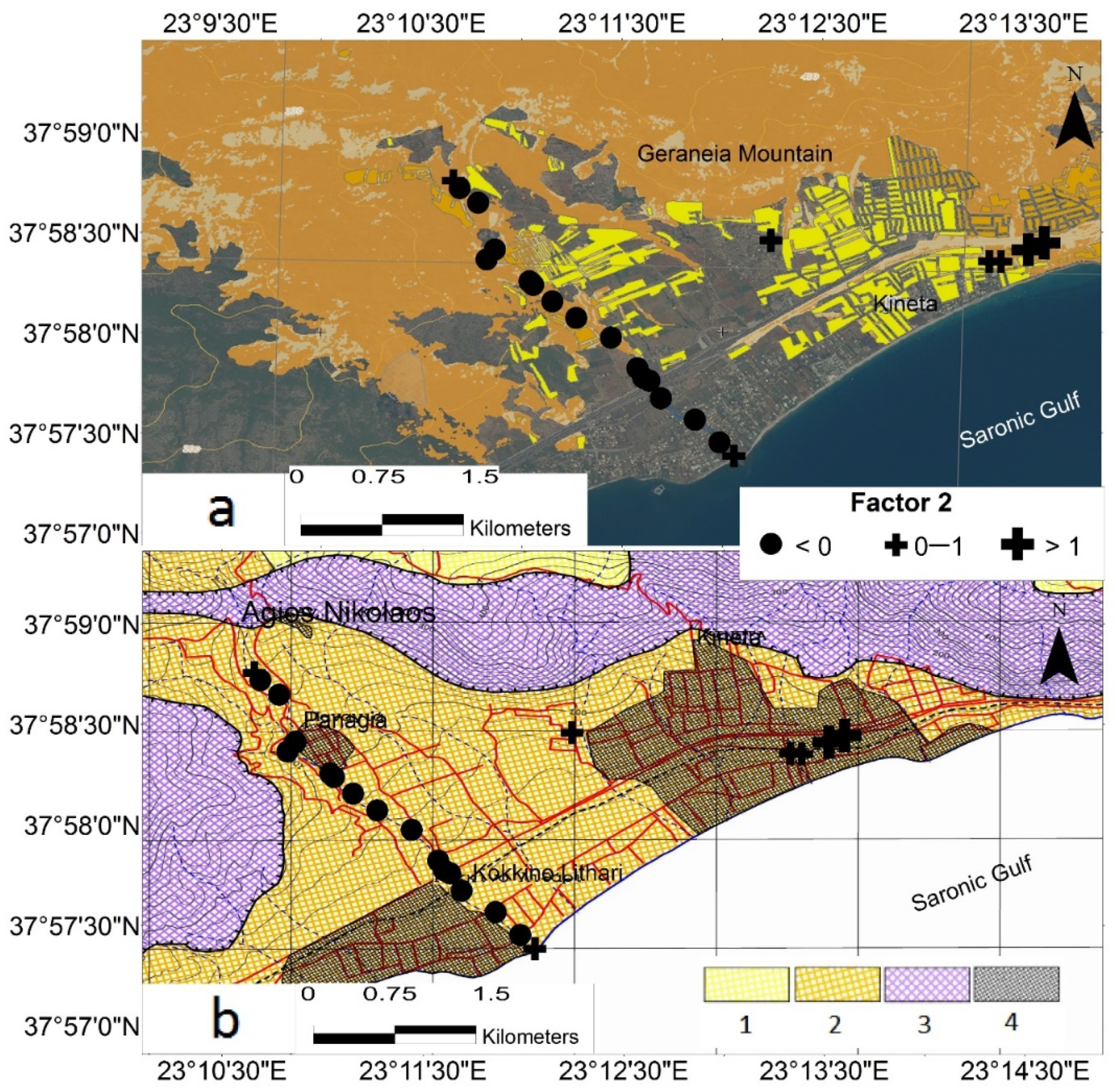
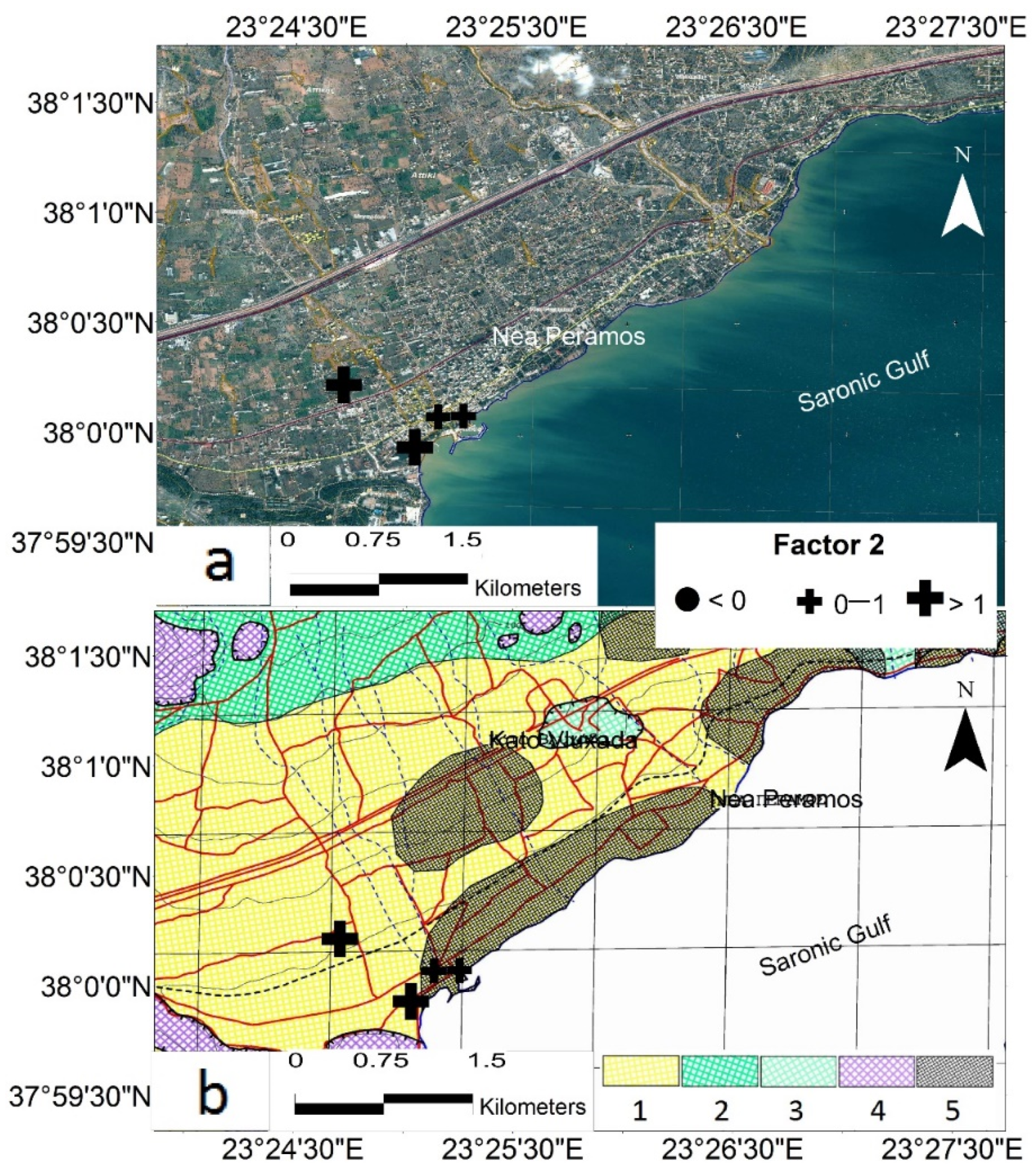
| Units | CEC | OM | pH | FeDTPA | MnDTPA | CuDTPA | ZnDTPA |
|---|---|---|---|---|---|---|---|
| cmol Mg2+Kg−1 | wt% | - | mg Kg−1 | mg Kg−1 | mg Kg−1 | mg Kg−1 | |
| West Attica stream | |||||||
| n | 26 | 26 | 26 | 26 | 26 | 26 | 26 |
| min | 4.04 | 1.10 | 7.17 | 10 | 11.7 | 0.4 | 0.8 |
| max | 38.7 | 13.3 | 8.28 | 92 | 93.7 | 8 | 53 |
| mean | 22.5 ± 8.2 | 7.73 ± 3.75 | 7.63 ± 0.22 | 50 ± 19 | 39.8 ± 22.1 | 2 ± 2 | 6 ± 11 |
| median | 22.2 | 7.27 | 7.63 | 47 | 32.7 | 0.8 | 3 |
| Kineta area (burned sites) | |||||||
| n | 14 | 14 | 14 | 14 | 14 | 14 | 14 |
| min | 14.1 | 1.10 | 7.30 | 29 | 18.3 | 0.4 | 0.8 |
| max | 35.2 | 12.80 | 8.28 | 92 | 93.7 | 2 | 53 |
| mean | 24.8 ± 6.4 | 8.81 ± 3.69 | 7.67 ± 0.22 | 52 ± 15 | 42.7 ± 22.9 | 1 ± 0.6 | 8 ± 14 |
| median | 25.5 | 9.45 | 7.63 | 51 | 35.4 | 0.9 | 3 |
| Kineta area (unburned sites) | |||||||
| n | 8 | 8 | 8 | 8 | 8 | 8 | 8 |
| min | 17.1 | 4.30 | 7.30 | 38 | 26.3 | 0.4 | 1 |
| max | 38.7 | 13.3 | 7.86 | 86 | 79.4 | 2 | 6 |
| mean | 25 ± 7. | 8.00 ± 3.01 | 7.6 ± 0.2 | 52 ± 16 | 46.5 ± 19.5 | 0.7 ± 0.5 | 3 ± 2 |
| median | 22.8 | 7.10 | 7.67 | 46 | 41.0 | 0.6 | 2 |
| Nea Peramos area (flooded sites) | |||||||
| n | 3 | 3 | 3 | 3 | 3 | 3 | 3 |
| min | 4.04 | 1.10 | 7.17 | 10 | 11.7 | 3 | 6 |
| max | 14.1 | 6.00 | 7.70 | 81 | 21.7 | 8 | 11 |
| mean | 9.23 ± 5.04 | 2.87 ± 2.72 | 7.45 ± 0.27 | 42 ± 36 | 16.5 ± 5.02 | 5 ± 3 | 8 ± 3 |
| median | 9.54 | 1.50 | 7.47 | 33 | 16.2 | 3 | 7 |
| Nea Peramos area (non-flooded site) | |||||||
| n | 1 | 1 | 1 | 1 | 1 | 1 | 1 |
| Measured Value | 13.2 | 4.90 | 7.68 | 17 | 16.2 | 5 | 8 |
| CuDTPA | FeDTPA | MnDTPA | ZnDTPA | Cdeg | |
|---|---|---|---|---|---|
| Mean of Kineta Streams | 0.9 | 52 | 44.1 | 6 | |
| Mean of Nea Peramos Streams | 5 | 35 | 16.4 | 8 | |
| Kineta CF | 0.9 | 1.37 | 1.78 | 1.2 | 5.25 |
| Nea Peramos CF | 5 | 0.920 | 0.661 | 1.6 | 8.18 |
| Element | DL | Mean | SD | Wildland Ash [12] | Mean Sediment [52] | Sediment Quality Criteria [53] |
|---|---|---|---|---|---|---|
| Al (wt %) | 0.01 | 1 | 0.3 | 1.52 | 10.2 | - |
| As (mg Kg−1) | 2 | 9 | 3 | 12 | 10.1 | 6 |
| Be (mg Kg−1) | 10 | 0.7 | 0.07 | 0.7 | 2.03 | - |
| Ca (wt %) | 10 | 17 | 5 | 14.25 | 5.81 | - |
| Cd (mg Kg−1) | 0.5 | 0.7 | 0.1 | 0.60 | 0.527 | 0.6 |
| Co (mg Kg−1) | 1 | 28 | 21 | 14 | 11.20 | - |
| Cr (mg Kg−1) | 1 | 131 | 77 | 72 | 92.80 | 26 |
| Cu (mg Kg−1) | 1 | 32 | 28 | 23.5 | 22.10 | 16 |
| Fe (wt %) | 0.01 | 2.4 | 1.1 | 2.24 | 2.25 | 2.12 |
| Ga (mg Kg−1) | 10 | 10 | 0 | n.d. | 12.1 | - |
| K (wt %) | 0.01 | 0.4 | 0.2 | 0.49 | 2.08 | - |
| La (mg Kg−1) | 10 | 12 | 4 | 10 | 41 | - |
| Mg (wt %) | 0.01 | 4 | 1 | 3.07 | 1.77 | - |
| Mn (mg Kg−1) | 5 | 532 | 139 | 612 | 716 | 460 |
| Ni (mg Kg−1) | 1 | 557 | 421 | 159 | 35.20 | 16 |
| P (mg Kg−1) | 10 | 2208 | 2307 | 1095 | 0.174 | - |
| S (wt %) | 0.01 | 0.09 | 0.08 | 0.10 | 0.092 | - |
| Sb (mg Kg−1) | 2 | 2 | 0 | 2 | 1.07 | - |
| Sc (mg Kg−1) | 1 | 4 | 1 | 3.5 | - | - |
| Sr (mg Kg−1) | 1 | 174 | 146 | 104 | 171 | - |
| Ti (wt %) | 0.01 | 0.02 | 0 | 0.03 | 0.685 | - |
| V (mg Kg−1) | 1 | 26 | 2 | 28.5 | 68.3 | - |
| Zn (mg Kg−1) | 2 | 108 | 78 | 118.5 | 98 | 120 |
| Variable | Factor 1 | Factor 2 | Communality |
|---|---|---|---|
| CuDTPA | - | 0.889 | 0.834 |
| FeDTPA | 0.833 | - | 0.694 |
| MnDTPA | 0.817 | −0.337 | 0.781 |
| ZnDTPA | - | 0.933 | 0.873 |
| OM | 0.901 | - | 0.832 |
| CEC | 0.884 | - | 0.836 |
| Variance | 3.00 | 1.85 | 4.85 |
| % Variance | 50.0 | 30.8 | 80.8 |
Publisher’s Note: MDPI stays neutral with regard to jurisdictional claims in published maps and institutional affiliations. |
© 2022 by the authors. Licensee MDPI, Basel, Switzerland. This article is an open access article distributed under the terms and conditions of the Creative Commons Attribution (CC BY) license (https://creativecommons.org/licenses/by/4.0/).
Share and Cite
Doufexi, M.; Gamvroula, D.E.; Alexakis, D.E. Elements’ Content in Stream Sediment and Wildfire Ash of Suburban Areas in West Attica (Greece). Water 2022, 14, 310. https://doi.org/10.3390/w14030310
Doufexi M, Gamvroula DE, Alexakis DE. Elements’ Content in Stream Sediment and Wildfire Ash of Suburban Areas in West Attica (Greece). Water. 2022; 14(3):310. https://doi.org/10.3390/w14030310
Chicago/Turabian StyleDoufexi, Maria, Dimitra E. Gamvroula, and Dimitrios E. Alexakis. 2022. "Elements’ Content in Stream Sediment and Wildfire Ash of Suburban Areas in West Attica (Greece)" Water 14, no. 3: 310. https://doi.org/10.3390/w14030310
APA StyleDoufexi, M., Gamvroula, D. E., & Alexakis, D. E. (2022). Elements’ Content in Stream Sediment and Wildfire Ash of Suburban Areas in West Attica (Greece). Water, 14(3), 310. https://doi.org/10.3390/w14030310








